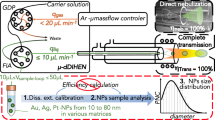Abstract
A demountable design of the static high sensitivity ICP (SHIP) for optical emission spectrometry is presented, and its use as an excitation source with the introduction of wet aerosols was investigated. Aerosols were produced by standard pneumatic sample introduction systems, namely a cross flow nebulizer, Meinhard nebulizer and PFA low flow nebulizer, which have been applied in conjunction with a double pass and a cyclonic spray chamber. The analytical capabilities of these sample introduction systems in combination with the SHIP system were evaluated with respect to the achieved sensitivity. It was found that a nebulizer tailored for low argon flow rates (0.3–0.5 L min−1) is best suited for the low flow plasma (SHIP). An optimization of all gas flow rates of the SHIP system with the PFA low flow nebulizer was carried out in a two-dimensional way with the signal to background ratio (SBR) and the robustness as optimization target parameters. Optimum conditions for a torch model with 1-mm injector tube were 0.25 and 0.36 L min−1 for the plasma gas and the nebulizer gas, respectively. A torch model with a 2-mm injector tube was optimized to 0.4 L min−1 for the plasma gas and 0.44 L min−1 for the nebulizer gas. In both cases the SHIP system saves approximately 95% of the argon consumed by conventional inductively coupled plasma systems. The limits of detection were found to be in the low microgram per litre range and below for many elements, which was quite comparable to those of the conventional setup. Furthermore, the short-term stability and the wash out behaviour of the SHIP were investigated. Direct comparison with the conventional setup indicated that no remarkable memory effects were caused by the closed design of the torch. The analysis of a NIST SRM 1643e (Trace Elements in Water) with the SHIP yielded recoveries of 97–103% for 13 elements, measured simultaneously.

Photo of the SHIP-III during operation




Similar content being viewed by others
References
Greenfield S, Berry CT, Jones IL (1964) Analyst 89:713–720
Wendt RH, Fassel VA (1965) Anal Chem 37:920–922
Butler OT, Cook JM, Harrington CF, Hill SJ, Rieuwerts J, Miles DL (2006) J Anal Atom Spectrom 21:217–243
Cornelis R, Caruso J, Crews H, Heumann K (2005) Handbook of elemental speciation II: species in the environment, food, medicine and occupational Health. Wiley, Chichester, England
Genna JL, Barnes RM, Allemand CD (1977) Anal Chem 49:1450–1453
Kornblum GR, Vanderwaa W, Degalan L (1979) Anal Chem 51:2378–2381
Kawaguchi H, Tanaka T, Miura S, Xu J, Mizuike A (1983) Spectrochim Acta B 38:1319–1327
Ripson PAM, Jansen LBM, De Galan L (1984) Anal Chem 56:2329–2335
Van Der Plas PSC, De Waaij AC, De Galan L (1985) Spectrochim Acta B 40:1457–1466
Savage RN, Hieftje GM (1979) Anal Chem 51:408–413
Weiss AD, Savage RN, Hieftje GM (1981) Anal Chim Acta 124:245–258
Seliskar CJ, Warner DK (1985) Appl Spectrosc 39:181–183
Jahl MJ, Jacksier T, Barnes RM (1992) J Anal Atom Spectrom 7:653–660
Jahl MJ, Barnes RM (1992) Spectrochim Acta B 47:923–934
Jahl MJ, Barnes RM (1992) J Anal Atom Spectrom 7:825–832
Breer C, Engel U, Klostermeier A, Buscher W, Broekaert JAC, Cammann K (2001) Appl Spectrosc 55:1462–1468
Klostermeier A, Engelhard C, Evers S, Sperling M, Buscher W (2005) J Anal Atom Spectrom 20:308–314
Engelhard C, Scheffer A, Nowak S, Vielhaber T, Buscher W (2007) Anal Chim Acta 583:319–325
Scheffer A, Brandt R, Engelhard C, Evers S, Jakubowski N, Buscher W (2006) J Anal Atom Spectrom 21:197–200
Mermet JM (1989) Spectrochim Acta B 44:1109–1116
Mermet JM (1991) Anal Chim Acta 250:85–94
Boumans PWJM (1991) Spectrochim Acta B 46:431–445
Boumans PWJM, Ivaldi JC, Slavin W (1991) Spectrochim Acta B 46:641–665
Mandel J (1964) The statistical analysis of experimental data. Wiley, New York
Acknowledgements
The authors acknowledge the funding provided by the Deutsche Forschungsgemeinschaft (DFG, Bu 1140/1–5). They also thank Patrick Klemens from AHF Analysentechnik for providing us with the cyclonic spray chamber and Dirk Ardelt from SPECTRO Analytical Instruments (Kleve, Germany) for technical support.
Author information
Authors and Affiliations
Corresponding author
Rights and permissions
About this article
Cite this article
Scheffer, A., Engelhard, C., Sperling, M. et al. Introducing wet aerosols into the static high sensitivity ICP (SHIP). Anal Bioanal Chem 388, 1605–1613 (2007). https://doi.org/10.1007/s00216-007-1378-9
Received:
Revised:
Accepted:
Published:
Issue Date:
DOI: https://doi.org/10.1007/s00216-007-1378-9




